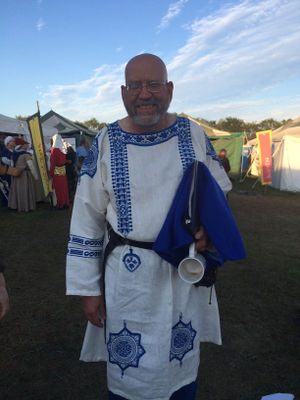William Walworth de Durham: Difference between revisions
No edit summary |
Bernadette (talk | contribs) |
||
| Line 34: | Line 34: | ||
**[[Great Western War 2013]] | **[[Great Western War 2013]] | ||
**[[Great Western War 2015]] | **[[Great Western War 2015]] | ||
* Chirurgeon, [[Talon Crescent War 2016]] | |||
==Classes Taught== | ==Classes Taught== | ||
Revision as of 11:26, 5 May 2016
| Photo | ||||||||||
|---|---|---|---|---|---|---|---|---|---|---|
 William | ||||||||||
| Information | ||||||||||
| ||||||||||
| Heraldry | ||||||||||
 Gules, a bend engrailed argent between a garb and three martlets Or. | ||||||||||
| Help with this sidebar |
His Lordship William Walworth de Durham
Motto
- "Compassion and Strength"
Persona
William is a late 13th/early 14th century “half-breed” Scottish English inhabitant of the “borders” area between England and Scotland. Although his father’s family was from the university town of Durham, he was born in Whitby, a port town in NorthYorkshire, England and educated at Whitby Abbey where Caedmon, the earliest English poet, lived. It was there that he developed his fondness for music and poetry.
When he was 12, both of his parents died from the fever and he went to live with his mother’s Clan Seton relatives in a fishing village in East Lothian, Scotland, situated on the coast of the Firth of Forth, which were granted to the Setons by King Maclolm III. There, he soon became involved in the Scottish independence movement, the Setons being interrelated by marriage with the family of Robert the Bruce. Because of his English roots, William was able to pass easily across the border and routinely gathered useful information for the Scottish armies. On occasion he, together with others of his Clan, were able to infiltrate English regiments prior to military engagements and then “switch sides” when the battle began, carrying important information about the English strategy and tactics. The Setons fought with Robert the Bruce at the Battle of Bannockburn in 1314 and there William’s role was discovered by the English and for the rest of his life he was hunted by the English forces and had a price on his head.
A few years before Bannockburn, William was requested by Bruce to administer the granting of certain lands to families and clans who had fought in support of Scottish independence. One of the grantees was Walter Logan, lord of Hartside and uncle of Lady Una Logan of Black Isle. William and Una met, fell instantly in love, pledged their handfast in 1305 and were married in 1306, shortly before Walter Logan was taken prisoner by English forces and hanged at Durham. With Bruce’s death in 1329, William and Una returned to her ancestral lands in the Black Isle where they continue to live a quiet life, spending their time enjoying the arts and music, interrupted by occasional requests of Scottish patriots for William’s diplomatic or clandestine assistance.
Offices & Positions
Kingdom
- Courtier, Conrad and Eleanor, 06/05/2010-11/06/2010
- Courtier, Patrick II and Kara II, 06/02/2012-11/03/2012
- Master Chirurgeon, 2012
- Ninth Bard of Caid, 2013
Western Seas
- Member of Court, Baroness Genevieve la Minstrelle, Western Seas, 2010
- Chirurgeon, Barony of Western Seas
- Herald, Canton of Peridot Isle, 2011-present
Event Staff
- Event Steward, Feast of Misrule 2014, 01/25/2014
- Chirurgeon-in-Charge
- Chirurgeon, Talon Crescent War 2016
Classes Taught
- Storytelling: A Bardic Workshop, Great Western War 2015
Projects & Publications
Memories
- Please feel free to add memories to this section.